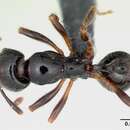Description
(
Inglês
)
fornecido por Zookeys
Worker description.
(10 measured) HL 0.75–0.93, HW 0.66–0.83 (0.82), FLD 0.20–0.23 (0.23), PCW 0.05–0.08 (0.06), SL 0.63–0.78 (0.76), EL 0.13–0.16 (0.16), ACL 0.63–0.74 (0.73), ML 1.02–1.26 (1.26), PrW 0.51–0.62 (0.61), PSL 0.12–0.14 (0.13), SDL 013–0.15 (0.14), PL 0.39–0.47 (0.47), PH 0.21–0.27 (0.26), PW 0.15–0.19 (0.18), PPL 0.24–0.30 (0.27), PPH 0.20–0.25 (0.24), PPW 0.19–0.24 (0.23), MFL 0.74–0.95 (0.91), MTL 0.58–0.75 (0.73), CI 87–92 (92), SI 91–96 (92), REL 18–21 (19), FLI 27–30 (28), PSI 0.9 (0.9), MFI 85–91 (90), ACI1 60–65 (64), ACI2 92–101.
Medium-sized species; general body color black to dark red-brown, with patches of dark brown on gaster; appendages mostly dark brown with joints and extremities a lighter orange-brown; setae dark golden brown; mandible usually with 6–7 teeth, consisting of 4 distinct apical teeth, a distinct basal tooth, and 1–2 inner teeth/denticles, which are usually worn and indistinct; basal margin of mandible straight, without a basal notch or depression; mandible surface mostly smooth and shiny, with scattered piligerous punctae and a few faint striae; anterior clypeal margin with median emargination; median lobe of clypeus obliquely flattened, mostly smooth and shiny, except for transverse carinula near anterior margin, remainder of clypeus mostly smooth and shiny; posterior extension of clypeus between antennal insertions somewhat wide (PCW 0.05–0.08), with sides subparallel to slightly diverging posteriad; frontal lobes of moderate width (FLD 0.20–0.23, FLI 27–30), not covering torular lobes in full-face view; head roughly oval-shaped (CI 87–92), with posterior margin flat, not depressed medially; eye relatively large (EL 0.13–0.16, REL 18–21), oval-shaped, with 7–9 ommatidia at greatest diameter; face completely smooth and shiny, except for variable number of very faint carinulae extending from frontal lobes to about midpoint of head, a few carinulae on gena, and scattered piligerous punctae; scape of moderate length (SI 91–96), usually reaching posterior margin of head when laid back; scape surface mostly smooth and shiny, with scattered piligerous punctae; funiculus with distinct 4-segmented antennal club; mesosoma almost completely smooth and shiny, except for transverse carinulae on propodeal dorsum, carinae along metanotal grove, and a few scattered rugulae and piligerous punctae; metanotal grove somewhat shallow and wide; propodeal dorsum in profile flat to distinctly convex; propodeal spines absent, at most forming nearly imperceptible nubs (PSL 0.12–0.14, PSI 0.9); petiole of moderate length (PL/HW 0.53–60); petiolar node in profile robust (PH/PL 0.54–0.60), wedge-shaped, with the anterior face long and sloping and the posterior face shorter and nearly vertical; node dorsum rounded, pointing vertically or slightly posteriad; petiolar node in profile robust, more globular than petiolar node, but similarly asymmetrical with long anterior face and short vertical posterior face; petiole and postpetiole mostly smooth and shining, with a few vestigial punctae; gaster smooth and shiny, with only scattered piligerous punctae; most of body dorsum with long standing pilosity; scape setae suberect to subdecumbent; setae on gastral tergites long, sparse, and uniformly suberect; setae on legs suberect to subdecumbent, with longer suberect setae on coxae and femoral venters.
Queen description.
(5 measured) HL 0.87–0.96 (0.90), HW 0.78–0.87 (0.81), FLD 0.24–0.27 (0.25), PCW 0.07–0.08 (0.07), SL 0.72–0.79 (0.76), EL 0.21–0.23 (0.23), ACL 0.70–0.77 (0.71), ML 1.23–1.43 (1.32), PrW 0.67–0.78 (0.74), PSL 0.11–0.15 (0.15), SDL 0.13–0.15 (0.15), PL 0.48–0.53 (0.48), PH 0.27–0.31 (0.29), PW 0.19–0.23 (0.21), PPL 0.30–0.33 (0.30), PPH 0.26–0.30 (0.29), PPW 0.26–0.30 (0.27), MFL 0.87–1.00 (0.93), MTL 0.67–0.79 (0.74), CI 90–92 (90), SI 91–93 (93), REL 26–28 (28), FLI 30–31 (30), PSI 0.9–1.0 (1.0), MFI 86–90 (87), ACI1 60–61 (60), ACI2 94–103 (94).
Same as worker except for standard queen modifications and the following: facial sculpture more developed, with distinct carinulae extending from frontal lobes to ocelli, and some carinulae on gena; pronotum with transverse striae near posterior margin; posterior third of mesoscutum with variable amount of striae/costae, orientation variable, most often longitudinal, but sometimes transverse, or obliquely angled mesad toward posterior margin; scutellum with variable number of longitudinal costae; propodeum with more distinct transverse carinae that extend across the dorsum to upper half of side; wing venation as in Figure 84D.
Male.
See Figure 84E–G.
- licença
- cc-by-3.0
- direitos autorais
- Michael G. Branstetter
- citação bibliográfica
- Branstetter M (2013) Revision of the Middle American clade of the ant genus Stenamma Westwood (Hymenoptera, Formicidae, Myrmicinae) ZooKeys 295: 1–277
- autor
- Michael G. Branstetter

